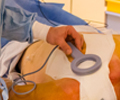March 2020 Br J Cardiol 2020;27:27–30 doi:10.5837/bjc.2020.006
Shirley Sze
Abstract

Dr Sze, BJCA essay prize winner
Introduction
According to the European Society of Cardiology Atlas project, >83 million people suffered from cardiovascular diseases in Europe in 2015.1 Heart failure (HF) is a common chronic disease in the ageing population. It is associated with poor prognosis, recurrent admissions and limited quality of life.2 Despite development of effective guideline-based treatment, the prognosis of HF patients remains poor. With the advancement of cyber technologies, digital healthcare has become more popular and may develop as a promising way to tackle challenges in HF management.
The objectives of this article are:
|
Full text
September 2019 Br J Cardiol 2019;26:90
Richard Baker
Abstract

NICE heart failure guidelines
The latest National Institute for Health and Care Excellence (NICE) guidelines for management of chronic heart failure (NG 106)1 were presented by Dr Abdallah Al-Mohammed (Sheffield Teaching Hospitals). It was fascinating to hear Dr Al-Mohammed describe his work on producing the guidelines with respect to what recommendations the authors are permitted to include and how recommendations may be presented.
Key changes include the removal of a history of a previous myocardial infarction from the initial assessment of a patient with suspected chronic heart failure. Other changes include the guidelines now using the te
|
Full text

July 2019 Br J Cardiol 2019;26:86–7 doi:10.5837/bjc.2019.023
Angela Graves, Nick Hartshorne-Evans
Abstract

There is no precise definition of what constitutes a HFSN, and the exact number of HFSNs and where they are located is not well understood. Therefore, one of the key recommendations of the inquiry was that Health Education England should work with the Royal College of Nursing and the Nursing and Midwifery Council to ascertain the number and location of HFSNs. Despite this recommendation, no particular body appeared to come forward to undertake this crucial piece of work. At the Pumping Marvellous Foundation’s Heart Failure Summit 2017,3 which was comprised of multi-stakeholders, the commitment was made by the charity, supported by an unres
|
Full text
May 2019 Br J Cardiol 2019;26:63–6 doi:10.5837/bjc.2019.019
Janine Beezer, Titilope Omoloso, Helen O’Neil, John Baxter, Deborah Mayne, Samuel McClure, Janet Oliver, Zoe Wyrko, Andy Husband
Abstract

Introduction
Frailty is a distinctive health state, related to the ageing process, in which multiple body systems gradually lose their in-built reserves, and is related to poorer outcomes.1 There have been numerous tools developed to identify frailty,2-4 often these tools are complex and not suitable for identifying patients at the time of admission to hospital, requiring a comprehensive geriatric assessment to validate them. The British Geriatrics Society developed the Frailsafe5,6 checklist, which was piloted across 12 UK hospitals in 2014 as part of the Frailsafe collaborative. The tool used three screening indicators to identify patients
|
Full text
May 2019 Br J Cardiol 2019;26:50
Gerald Chi, Syed Hassan Abbas Kazmi, C. Michael Gibson
Abstract

ACC.19 was held in New Orleans, US
PARTNER 3 and Evolut Low Risk add to evidence base for TAVR
Prior literature suggests that transcatheter aortic-valve replacement (TAVR) is non-inferior or even superior to standard surgical aortic-valve replacement (SAVR) among high and intermediate surgical risk patients with aortic stenosis (AS). Two pivotal studies have now addressed the efficacy and safety of TAVR in AS patients at low mortality risk from surgery.
PARTNER 3 (ClinicalTrials.gov: NCT02675114) was an open-label trial that randomised 1,000 subjects with severe AS at low mortality risk from surgery into either TAVR with a third-generation ba
|
Full text

October 2018 Br J Cardiol 2018;25(suppl 3):S20–S24 doi:10.5837/bjc.2018.s15
Balrik Singh Kailey, Christopher Allen, Badrinathan Chandrasekaran
Abstract

Introduction
Device therapy has revolutionised the landscape of heart failure over the past 10 years. Prior to device therapy, the most important trials in heart failure (HF) management centred on pharmacotherapy. The CONSENSUS (Cooperative North Scandinavian Enalapril Survival Study) trial (1987),1 showed the importance of optimal blockade of the renin–angiotensin–aldosterone system (RAAS). Similarly, CIBIS-II (Cardiac Insufficiency Bisoprolol Study II) (1999)2 and RALES (Randomized Aldactone Evaluation Study) (1999)3 trials did the same for beta-blockade and spironolactone, respectively.
This century, device therapy has also become part
|
Full text
August 2018 Br J Cardiol 2018;25:97–101 doi:10.5837/bjc.2018.025
Navneet Kalsi, Sarah Birkhoelzer, Philip Kalra, Paul Kalra
Abstract

Introduction
Modulation of the RAAS is an integral part of the management for patients with chronic heart failure, prior myocardial infarction and diabetic nephropathy. Evidence from large scale trials demonstrates the clear prognostic benefit of angiotensin-converting enzyme (ACE) inhibitors, angiotensin receptor blockers, mineralocorticoid receptor antagonists and more recently angiotensin receptor neprilysin inhibitors for these high-risk groups.1-3 The use of these agents, particularly in combination, can be associated with hyperkalaemia, although the incidence is unknown.4 A clear trend exists between the development of hyperkalaemia and
|
Full text

June 2018 Br J Cardiol 2018;25:73–6 doi:10.5837/bjc.2018.016
Miles Fisher, Emma Johns, Gerry McKay
Abstract

(more…)
|
Full text
January 2018 doi:10.5837/bjc.2018.002 Online First
Alison Carr, Fosca De Iorio, Martin R Cowie
Abstract

Introduction
Acute heart failure (AHF) syndromes are the leading cause of hospitalisation in patients over 65 years of age in the UK, accounting for 67,000 admissions per year.1
The immediate management of AHF focuses on symptom relief and stabilisation of the patient’s haemodynamic profile – traditionally achieved with a combination of oxygen, diuretics and nitrate therapy.1-5 Recent guidelines from the National Institute for Health and Care Excellence (NICE),1 and the European Society of Cardiology (ESC),5 have highlighted the poor-quality evidence base for many of these interventions.3,4,6
The ESC guidelines (updated in 2016) state th
|
Full text
August 2017 Br J Cardiol 2017;24:(3) Online First
BJC Staff, Dr Richard Crawley, Dr Brian Halliday, Dr Rosita Zakeri
Abstract

Landmark trials in heart failure – 30 years from CONSENSUS
With 2017 marking the 30th year since the publication of CONSENSUS,1 which first reported a reduction in mortality with enalapril versus placebo in patients with advanced heart failure (HF), the BCS held a dedicated session to review the seminal clinical trials and advances in chronic heart failure management in this period.
Dr Rosita Zakeri (Royal Brompton Hospital, London) reviewed this session for us and spoke to the BJC afterwards.
Rosita Zakeri
The era of vasodilator therapy for heart failure began in the 1990s. Professor Karl Swedberg (University of Gothenberg, Sweden) began
|
Full text





